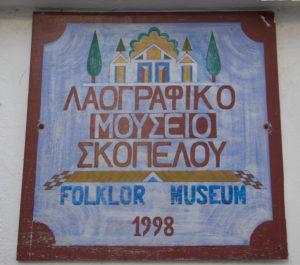In the northwestern part of Skopelos lies the most impressive village on the island: Glossa,
along with its two nearby settlements, Loutraki and Mahalas. Glossa is the second-largest village of Skopelos with about 750 permanent residents and lies 32 km away from Skopelos Chora.
It is built on the hill above the port of Loutraki at an altitude of about 300 meters. Due to its breathtaking view, it has been described as the “balcony of the Aegean”. The houses embrace the mountain and descend downwards, gazing between the island of Skiathos and Northern Evia. That is why Alexandros Papadiamantis mentions it as the high village, in his short story “Homesick“.
Etymology of the name Glossa
There are several approaches to the etymology of its name. Glossa [Γλώσσα] means tongue in Greek and some attribute the name of the village to the shape of its nearby cape. Others associate it with Knosa, a town built at the same location by the first inhabitants of Skopelos. It is probable that these people were Cretans of the Minoan era. It is argued that Knossa is an altered form of Knossos, the ancient city of Crete. A more humorous etymology given by the locals is that of one’s tongue “hanging out” after climbing the many steps of the village.
History of Glossa Skopelos
The settlement of Glossa Skopelos seems to have been inhabited since ancient times, as traces of prehistoric residences have been discovered. As mentioned above, it was probably a Cretan colony of the Minoan era. These ancient settlements were welded in narrow pits near the sea, surrounded by walls and adjacent to farmlands. The surrounding area, both in Glossa and Loutraki, is of great archaeological interest. In many places, there are ancient towers and buildings, from different periods of antiquity. In antiquity, the city of Selinus was developed here, very close to the modern settlement.
The Monastery of Aghios Taxiarchis
The monastery of Aghios Taxiarchis is located in a pine-covered area of Glossa and overlooks the north side of the island. We find it on the way to the beach of Perivoliou. Today it is deserted, but since 1770 it pertained to the monastery of Xiropotamos of Mount Athos and several monks resided in it. According to a stone plaque above the entrance, the monastery of Aghios Taxiarchis was built in 1672 and it was renovated during the years of Turkish rule. An ossuary, as well as remains of an early Christian temple dating from 672 AD are preserved in the courtyard. South of the monastery there is a spring with plenty of water. It is the oldest Christian temple on Skopelos.
Folklore Museum of Glossa Skopelos
In the center of the famous, historical, and beautiful village of Glossa, there is also a Folklore Museum, the Folklore Museum of Glossa Skopelos. More specifically, it is located above the church of the Assumption of the Virgin Mary.
It is a two-story traditional house, in which the visitor will have the opportunity to see traditional costumes and everyday household items. You are also given the opportunity to be informed about the interior design and decoration that characterized a typical traditional house of the village. During the summer months, the Folklore Museum of Glossa is open in the morning and afternoon, but it would be helpful to confirm this with your hotel reception.
The lighthouse at the northern end of Skopelos
At Cape Gourouni, about 8 km from Glossa, a picturesque lighthouse dominates the landscape. Built in 1889, it is located on a bosky mountain slope with pistacias and strawberry trees. To reach the lighthouse, travelers have to follow an interesting route through pine forests and rocky landscapes. The path from the lighthouse ends over the steep shores, near the sea.
Glossa and the wider region are rich in water springs and have many plums, olive, and almond trees. The majority of its inhabitants were mostly engaged in the cultivation of vines, while others were sailors and captains. In fact, in Loutraki, there was even a shipyard.
The houses in Glossa have obvious Macedonian influences. They are two-story with ceramic roofs and wooden balconies, the front of which is covered with iron railings. The interior is traditional, with wooden ceilings, stairs, and short doors. Throughout its cobbled streets, travelers will still meet the warm-hearted locals who preserve their traditional way of life, customs, and linguistic idiom.
In the northwestern part of Skopelos, Glossa fascinates visitors with its magnificent views and the wonderful sunset it offers; a picturesque village with a traditional vibe that will certainly impress you.





